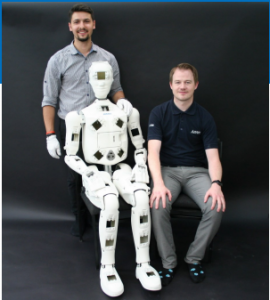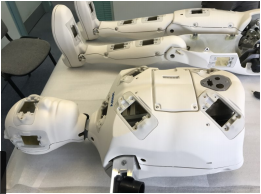 Automotive manufacturers use dummies for more than just testing how well a vehicle will hold up in a crash. They also use them to test comfort factors, such as temperature and other environmental conditions. Recently, ARRK Engineering was in need of a dummy to help automotive manufacturers test passenger thermal comfort and environmental conditions in cars, and it turned to ARRK’s prototyping division to help develop a dummy using 3D printing.
Automotive manufacturers use dummies for more than just testing how well a vehicle will hold up in a crash. They also use them to test comfort factors, such as temperature and other environmental conditions. Recently, ARRK Engineering was in need of a dummy to help automotive manufacturers test passenger thermal comfort and environmental conditions in cars, and it turned to ARRK’s prototyping division to help develop a dummy using 3D printing.
The main body parts of the dummy were designed to be fixed together with ball joints and angle joints that are lockable in various positions, enabling the simulation of passenger movement inside the vehicle. It also had needed sensors to measure air temperature, air velocity, radiation and relative humidity on the surface of the body panels.
The CAD data for the dummy was sent to ARRK’s prototyping center in Gloucester, where 26 components were 3D printed with ARRK’s selective laser sintering (SLS) process using glass filled nylon material. Those components included the dummy’s head, arms, legs, torso, hands and feet. In addition to the 3D printed parts, more than 60 components were CNC machined from steel and aluminum. These parts also included some welded fabrications that the Gloucester team fitted inside the SLS 3D printed parts.
The project designers, who are based at ARRK Engineering’s site in Cluj-Napoca, Romania, communicated regularly with the prototyping team to make sure that the parts were being built to schedule and and in line with the characteristics specified for each component. The parts were then painted in ARRK’s in-house paint shop and color matched to exact RAL requirements.
 The project’s lead engineer visited the prototyping center and worked with the Gloucester team to assemble the dummy and make sure that it worked as expected. After assembly, it was shipped to ARRK’s engineering headquarters in Munich, which employs more than 1,000 people. Once it arrived in Munich, the dummy was fitted with sensors and pressure pads.
The project’s lead engineer visited the prototyping center and worked with the Gloucester team to assemble the dummy and make sure that it worked as expected. After assembly, it was shipped to ARRK’s engineering headquarters in Munich, which employs more than 1,000 people. Once it arrived in Munich, the dummy was fitted with sensors and pressure pads.
3D printing has been used to make crash test dummies as well; the technology is useful in that it can create easily customized dummies to represent people of all ages, sizes, genders and body types. Humanetics, which makes crash test dummies, is even considering making 3D printed replicas of individual organs in order to better understand how each organ can be impacted by an automobile accident. 3D printing is allowing testing dummies, whether for crash testing or other purposes, to be made more and more realistic.
 ARRK, which was founded in 1948, is one of the world’s largest product development specialists. Through a series of acquisitions and mergers, it has become a global company with offices all over the world, more than 20 locations and over 3,000 employees. ARRK offers not only product development but low volume production as well. Three years ago, the company opened a facility dedicated to 3D printing in Poland – not its first rapid prototyping facility, but a sign that ARRK was embracing 3D printing to a larger extent. ARRK offers several 3D printing technologies, including FDM, SLS, SLA, Polyjet and DMLS.
ARRK, which was founded in 1948, is one of the world’s largest product development specialists. Through a series of acquisitions and mergers, it has become a global company with offices all over the world, more than 20 locations and over 3,000 employees. ARRK offers not only product development but low volume production as well. Three years ago, the company opened a facility dedicated to 3D printing in Poland – not its first rapid prototyping facility, but a sign that ARRK was embracing 3D printing to a larger extent. ARRK offers several 3D printing technologies, including FDM, SLS, SLA, Polyjet and DMLS.
Discuss this and other 3D printing topics at 3DPrintBoard.com or share your thoughts below.
[Images: ARRK]
Subscribe to Our Email Newsletter
Stay up-to-date on all the latest news from the 3D printing industry and receive information and offers from third party vendors.
Print Services
Upload your 3D Models and get them printed quickly and efficiently.
You May Also Like
Making 3D Printing Personal: How Faraz Faruqi Is Rethinking Digital Design at MIT CSAIL
What if your 3D printer could think more like an intelligent assistant, able to reason through a design idea, ask questions, and deliver something that works exactly the way the...
Reinventing Reindustrialization: Why NAVWAR Project Manager Spencer Koroly Invented a Made-in-America 3D Printer
It has become virtually impossible to regularly follow additive manufacturing (AM) industry news and not stumble across the term “defense industrial base” (DIB), a concept encompassing all the many diverse...
Heating Up: 3D Systems’ Scott Green Discusses 3D Printing’s Potential in the Data Center Industry
The relentless rise of NVIDIA, the steadily increasing pledges of major private and public investments in national infrastructure projects around the world, and the general cultural obsession with AI have...
Formlabs Teams Up with DMG MORI in Japan
In late June, Nick Graham, Chief Revenue Officer at Formlabs, announced on LinkedIn that the company had partnered with DMG MORI, one of the world’s leading machine tool companies, to...

































